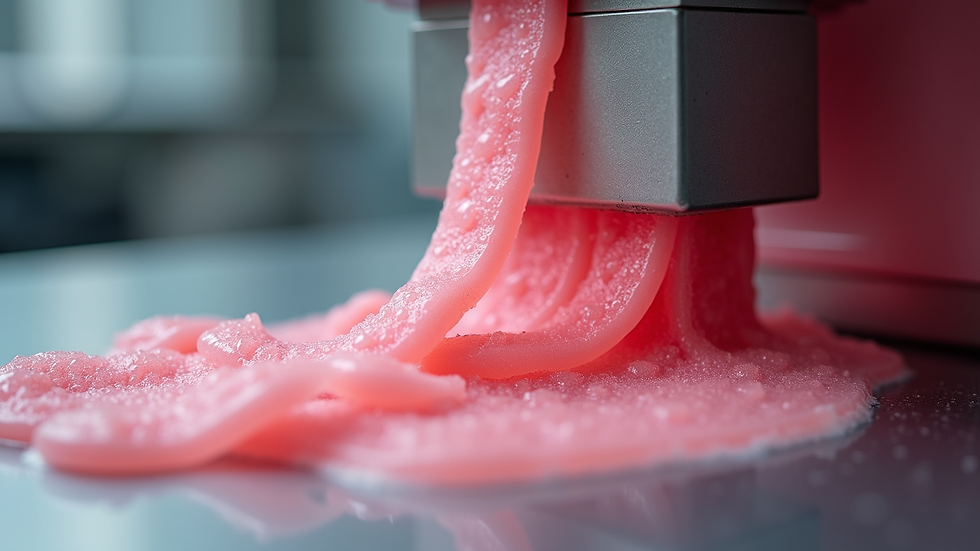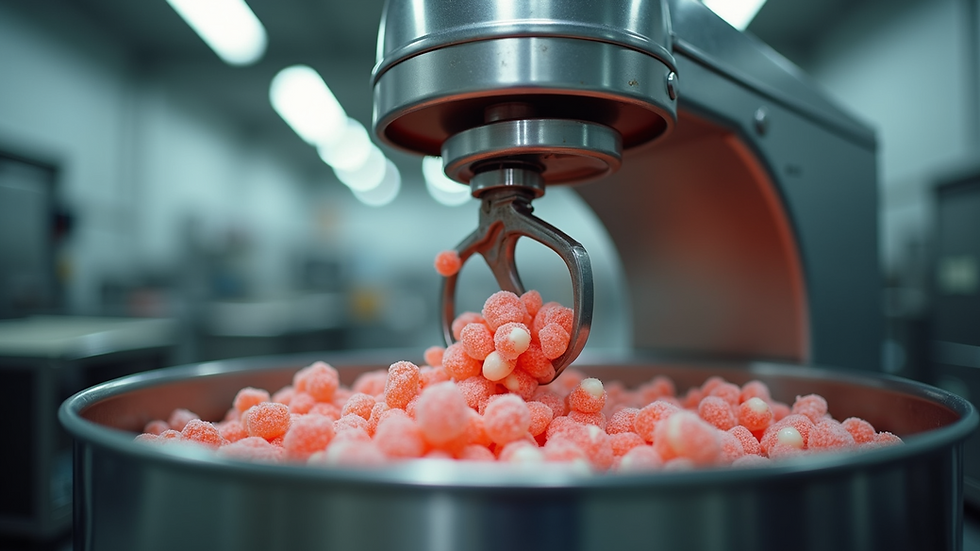Understanding the Role of Extruders in Gum Manufacturing
- Usman Akram

- Jun 10
- 5 min read
In the world of candy manufacturing, few products capture the imagination quite like bubble gum. The ability to blow bubbles and experience that burst of flavor creates a unique experience for consumers. However, the manufacturing process behind bubble gum is intricate and often overlooked. Among the key players in this process is the extruder, specifically designed for creating high-quality bubble gum. In this post, we will explore the role of extruders in gum manufacturing, particularly focusing on bubble gum production.
What is a Bubble Gum Extruder?
A bubble gum extruder is a specialized machine that converts raw ingredients into a cohesive gum mass. This machine mixes, heats, and shapes the gum base while providing the necessary texture and elasticity needed for bubble formation. During the extrusion process, ingredients such as sugar, flavoring, and texturizers are blended uniformly. The extruder's ability to maintain the correct temperature and pressure is critical to producing a consistent product.

The Science Behind Extrusion
Extrusion is a thermodynamic process where materials are forced through a die to create specific shapes. In the context of bubble gum, extrusion serves several purposes:
Mixing: The extruder combines all ingredients uniformly. Consistency in flavor and texture is vital for commercial success.
Heating: As ingredients are processed, friction generates heat, which helps soften the gum base. This is crucial for allowing the ingredients to blend smoothly.
Shaping: The final product is shaped as it exits the extruder die. The die can be adjusted to create different forms, such as sticks or pellets.
The temperature and pressure conditions within the extruder need to be meticulously controlled. Too much heat can damage the flavoring agents while too little can prevent proper blending.
Benefits of Using Extruders in Gum Manufacturing
Utilizing an extruder in gum manufacturing provides numerous benefits:
Efficiency: Extruders automate the mixing and shaping process, allowing for high-speed production. This efficiency can significantly reduce labor costs and production time.
Consistency: The controlled environment of the extruder helps ensure that each batch of gum maintains a uniform texture and flavor profile. This consistency is essential for building brand loyalty.
Versatility: Extruders can accommodate various formulations, making them adaptable for different gum types, including sugar-free options. This allows manufacturers to develop and innovate new products quickly.
Reduction of Waste: The precise nature of extrusion minimizes waste of raw materials, which can lead to cost savings over time.

Types of Extruders Used in Gum Manufacturing
There are several types of extruders used in gum manufacturing, each designed for specific needs:
Single-Screw Extruders
Single-screw extruders are commonly used in bubble gum production because of their simplicity and effectiveness. These machines use one rotating screw to push the gum base through the barrel and die. They are suitable for consistent and straightforward gum formulations.
Twin-Screw Extruders
Twin-screw extruders feature two intermeshing screws, offering superior mixing and blending capabilities. They are particularly useful for complex formulations with multiple ingredients, such as sugar-free gums that require additional sweeteners and binding agents.
Co-Rotating Extruders
Co-rotating extruders, a subtype of twin-screw extruders, allow for better control over heat and shear. This control is vital for achieving the right consistency, especially when using sensitive ingredients in the gum base.
Batch vs. Continuous Extruders
Batch extruders process small amounts of material at a time, while continuous extruders operate non-stop, feeding material continuously. Continuous extruders provide better efficiency for large-scale production, which is essential for popular bubble gum brands.

Key Ingredients in Bubble Gum Production
The extruder plays a pivotal role in processing key ingredients used in bubble gum. Here are some main components:
Gum Base: The backbone of bubble gum, providing chewiness. Gum bases may include natural or synthetic rubbers, resins, and waxes.
Sweeteners: Sugar is the traditional sweetener for bubble gum, but alternatives like high fructose corn syrup and sugar alcohols are increasingly popular due to health concerns.
Flavors: Flavorings can be natural or artificial, giving consumers a myriad of tastes, from classic mint to exotic fruit flavors.
Coloring Agents: Colorants enhance the visual appeal and play an essential role in product marketing.
Softening Agents: These agents increase the gum's pliability, ensuring it has the right texture for chewing and blowing bubbles.
The extruder must ensure all these ingredients are uniformly mixed and heated to achieve the desired final product characteristics.
Troubleshooting Common Issues in Extrusion
Despite their advantages, extruders can present challenges during the gum manufacturing process. Here are some common issues and potential solutions:
Inconsistent Texture
Inconsistent texture may result from improper mixing or incorrect temperature settings. To solve this issue, regularly calibrate your equipment to ensure even mixing and maintain optimal temperature.
Flavor Loss
If the gum loses flavor too quickly, it may be due to overheating during extrusion. Monitor the temperature and adjust as necessary to minimize flavor degradation.
Poor Bubble Formation
If the gum does not form proper bubbles, it could be attributed to a lack of elasticity in the gum base. Adjust the formulation to include better binders or softening agents to enhance bubble formation.
Production Downtime
Unexpected downtime can be costly. Regular maintenance is crucial to prevent breakdowns. Utilize predictive maintenance tools to help monitor machinery performance and preemptively address issues.
With proper troubleshooting techniques and regular maintenance, manufacturers can ensure a reliable and efficient production process.
Future Trends in Gum Manufacturing
As the confectionery industry continues to evolve, several trends are emerging that will likely impact gum manufacturing:
Health-Conscious Alternatives: With growing health awareness, sugar-free and all-natural gums are gaining popularity. Extruders must adapt to accommodate these changing formulations.
Sustainability: Consumers increasingly prioritize sustainability. Eco-friendly packaging and sustainable sourcing of ingredients are becoming key differentiators for brands.
Customization: Personalized gum flavors and formulations are on the rise. Advanced extruder technology allows for quick adjustment to formulations, catering to consumer demands.
The role of extruders in gum manufacturing will continue to evolve alongside these trends, ensuring that gum remains a staple in the confectionery market.
Final Thoughts on the Role of Extruders in Gum Manufacturing
Extruders play an essential role in the production of bubble gum, impacting everything from texture and flavor to efficiency and consistency. By understanding how these machines work and the various factors to consider in gum manufacturing, businesses can streamline their processes and produce a beloved product that delights consumers. As the industry moves forward, manufacturers must stay attuned to new trends and challenges, ensuring that their production lines remain competitive and innovative. As you delve deeper into the world of gum production, don't forget to explore opportunities, such as incorporating a bubble in gum line, that can enhance your manufacturing capabilities.
By harnessing the power of technology and innovation in the extrusion process, manufacturers can continue creating tasty and fun chewing gum that stands the test of time.




Comments